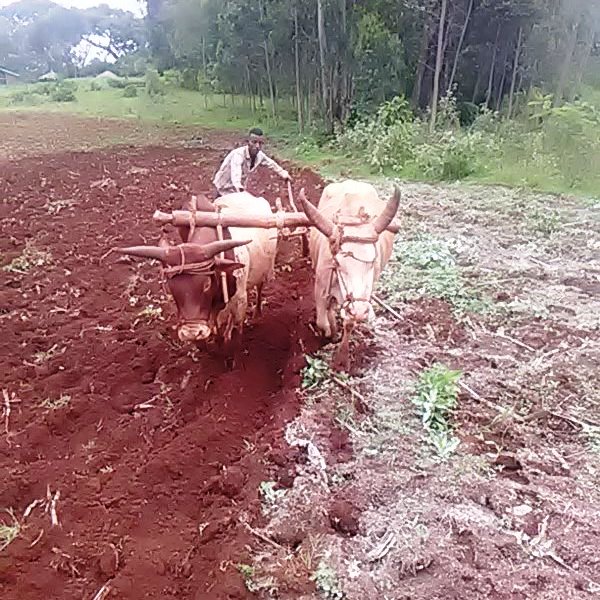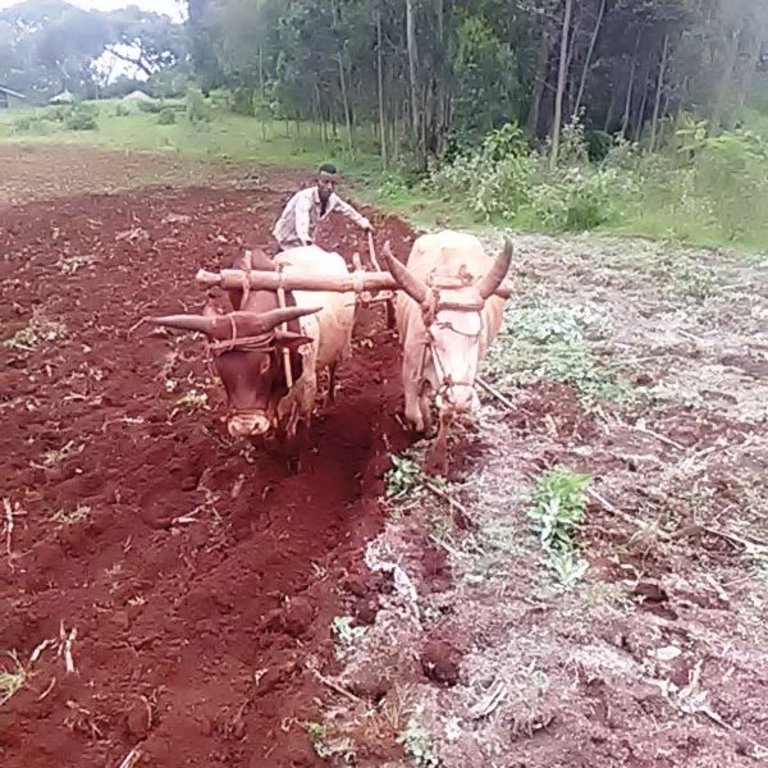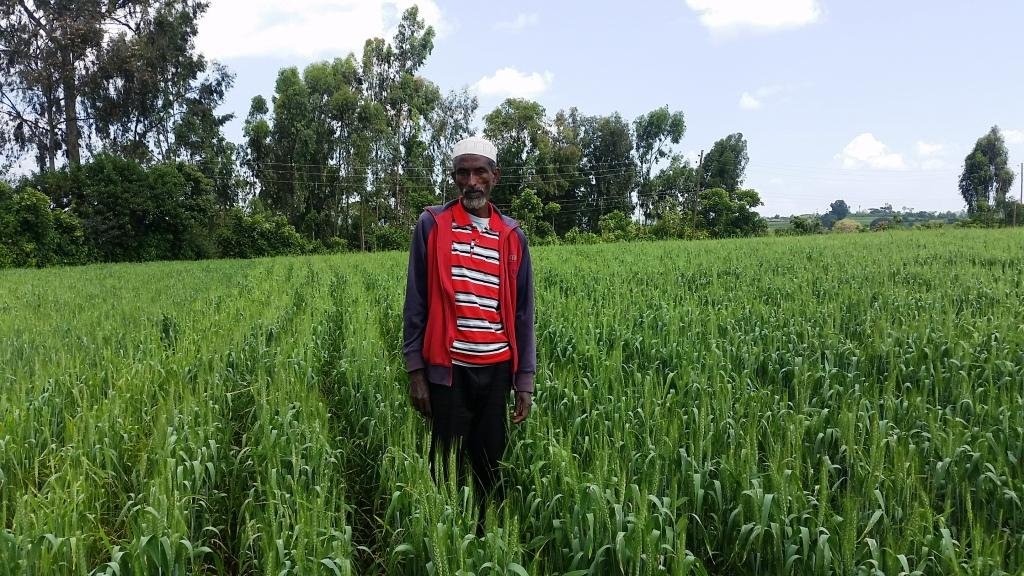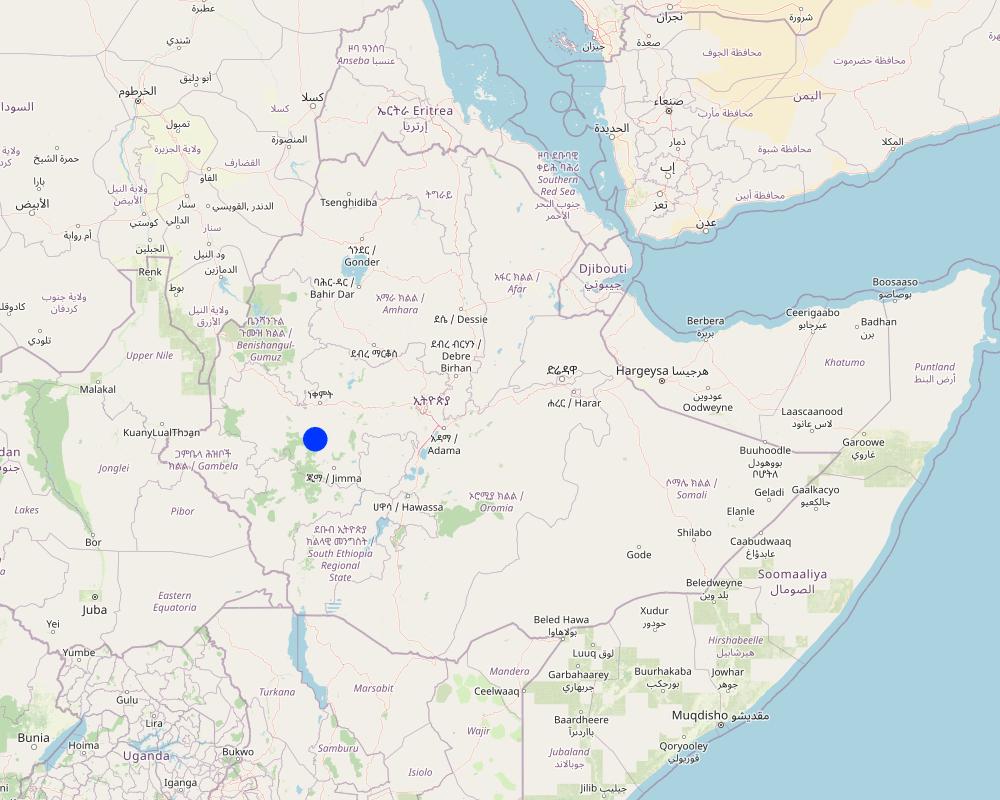Treating acid soils with lime [Ethiopia]
- Creation:
- Update:
- Compiler: GERBA LETA
- Editors: Noel Templer, Julia Doldt, Kidist Yilma, Tabitha Nekesa, Ahmadou Gaye, Siagbé Golli
- Reviewers: William Critchley, Rima Mekdaschi Studer, Sally Bunning
Biyyoo dhangagaa'e nooratiin haakiimu
technologies_6641 - Ethiopia
View sections
Expand all Collapse all1. General information
1.2 Contact details of resource persons and institutions involved in the assessment and documentation of the Technology
Key resource person(s)
land user:
Benti Mohammed
Farmer
Ethiopia
Name of project which facilitated the documentation/ evaluation of the Technology (if relevant)
Soil protection and rehabilitation for food security (ProSo(i)l)Name of the institution(s) which facilitated the documentation/ evaluation of the Technology (if relevant)
CIAT International Center for Tropical Agriculture (CIAT International Center for Tropical Agriculture) - Kenya1.3 Conditions regarding the use of data documented through WOCAT
The compiler and key resource person(s) accept the conditions regarding the use of data documented through WOCAT:
Yes
1.4 Declaration on sustainability of the described Technology
Is the Technology described here problematic with regard to land degradation, so that it cannot be declared a sustainable land management technology?
No
Comments:
Lime ameliorates the degraded soil due to growing soil acidity.
1.5 Reference to Questionnaire(s) on SLM Approaches (documented using WOCAT)
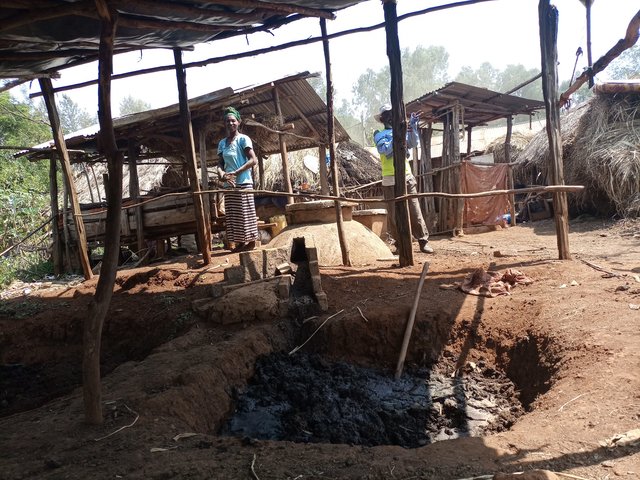
Integrated Soil Fertility Management (ISFM) [Ethiopia]
The Integrated Soil Fertility Management (ISFM) approach has been adopted under the Integrated Soil Fertility Management Project (ISFM+). It was introduced as a quick-win solution to increase both crop and biomass production through the incremental promotion of varied but complementary technology packages.
- Compiler: GERBA LETA
2. Description of the SLM Technology
2.1 Short description of the Technology
Definition of the Technology:
Acidic soils deprive crops of their full nutrient absorption capacity. Lime application to these soil makes them less acidic. It breaks the barrier that fixes nutrients and ensures crops access to vital soil nutrients that unleash their productivity potential.
2.2 Detailed description of the Technology
Description:
Acidic soils deprive crops of their full nutrient absorption capacity. The farm under the assessment has soil with a pH below 5.0. Lime application to these soil (liming) makes them less acidic. It breaks the barrier that fixes nutrients and ensures crops access to vital soil nutrients that unleash their productivity potential. Soil amendment with lime needs to be at least a month in advance of planting the intended crop. It requires thoroughly mixing the lime powder into the soil. The crop response from the treated soil is gradually visible, particularly during the second cropping season. Lime application takes place after the soil is pulverized very well. Most small cereals (for example “tef”, Eragrostis tef, wheat and barley) need tillage at least four times to create a good environment for the small seeds to emerge and quickly compete effectively with the weeds.
Treating exhausted acidic soils enhances the availability of nutrients that otherwise remain fixed by non-leaching mineral elements in the soil. Application of lime along with organic fertilizers improves soil structure, soil pore space, and soil infiltration capacity. Treating acid soil increases crop production and productivity of the soil. It reduces labour costs relative to output, since it leads to a relatively high yield from a small area. The practice helps to stop land being converted from cropping to grazing. Even when this conversion occurs, the grazing land itself is poor because of the acidity and may be abandoned and simply become unproductive degraded land.
However, availability and accessibility of lime, transportation, and manual application to the farmland are challenging. Based on the degree of soil acidity, the amount of lime required can be high. Apart from the large quantity required (4 or more tonnes per ha), the price per unit is discouraging to smallholder farmers. The high price, poor supply, and delays in delivery are the main challenges to effectively address the prevailing issues of soil acidity.
2.3 Photos of the Technology
General remarks regarding photos:
The photos portray liming improves the vigor of crops by improving the productivity of soil that was once plagued by soil acidity that fixes the nutrients in the soil.
2.4 Videos of the Technology
Comments, short description:
Videos of this technology is not documented.
2.5 Country/ region/ locations where the Technology has been applied and which are covered by this assessment
Country:
Ethiopia
Region/ State/ Province:
Oromia
Further specification of location:
Gechi district, Gito kebele
Specify the spread of the Technology:
- evenly spread over an area
If precise area is not known, indicate approximate area covered:
- < 0.1 km2 (10 ha)
Is/are the technology site(s) located in a permanently protected area?
No
Comments:
The technology applied on the farmland that is located closer to the homestead.
Map
×2.6 Date of implementation
Indicate year of implementation:
2017
2.7 Introduction of the Technology
Specify how the Technology was introduced:
- through projects/ external interventions
- Bureau/office of agriculture
Comments (type of project, etc.):
The project is an Integrated Soil Fertility Management (ISFM+) with a focus on acid soil management in the highland and high rainfall regions of Ethiopia through the application of integrated practices, and by adopting a participatory.
3. Classification of the SLM Technology
3.1 Main purpose(s) of the Technology
- improve production
- reduce, prevent, restore land degradation
- conserve ecosystem
- preserve/ improve biodiversity
- create beneficial economic impact
3.2 Current land use type(s) where the Technology is applied
Land use mixed within the same land unit:
No

Cropland
- Annual cropping
Annual cropping - Specify crops:
- cereals - wheat (spring)
- cereals - maize
- cereals - millet
Number of growing seasons per year:
- 1
Is intercropping practiced?
No
Is crop rotation practiced?
Yes
If yes, specify:
Rotate large cereals with small cereals, or the legume crops.
3.3 Has land use changed due to the implementation of the Technology?
Has land use changed due to the implementation of the Technology?
- No (Continue with question 3.4)
Land use mixed within the same land unit:
No
3.4 Water supply
Water supply for the land on which the Technology is applied:
- rainfed
3.5 SLM group to which the Technology belongs
- rotational systems (crop rotation, fallows, shifting cultivation)
- integrated crop-livestock management
- integrated soil fertility management
3.6 SLM measures comprising the Technology

agronomic measures
- A2: Organic matter/ soil fertility
- A7: Others

other measures
Specify:
It is a topsoil treatment or management by incorporating lime into the soil.
Comments:
The agronomic measures also involve the application of lime and mixing up with the soil weeks before planting the main crop.
3.7 Main types of land degradation addressed by the Technology

soil erosion by water
- Wt: loss of topsoil/ surface erosion
- Wo: offsite degradation effects

chemical soil deterioration
- Cn: fertility decline and reduced organic matter content (not caused by erosion)
- Ca: acidification

physical soil deterioration
- Pc: compaction
- Ps: subsidence of organic soils, settling of soil

biological degradation
- Bc: reduction of vegetation cover
- Bq: quantity/ biomass decline
- Bs: quality and species composition/ diversity decline
- Bl: loss of soil life
- Bp: increase of pests/ diseases, loss of predators
Comments:
The technology improves biomass production and the biodiversity of the farmland.
3.8 Prevention, reduction, or restoration of land degradation
Specify the goal of the Technology with regard to land degradation:
- reduce land degradation
- restore/ rehabilitate severely degraded land
Comments:
The technology reduces soil acidity, improves soil productivity, and increases crop production.
4. Technical specifications, implementation activities, inputs, and costs
4.2 General information regarding the calculation of inputs and costs
Specify how costs and inputs were calculated:
- per Technology area
Indicate size and area unit:
Sanga 4
If using a local area unit, indicate conversion factor to one hectare (e.g. 1 ha = 2.47 acres): 1 ha =:
1 ha = 8 Sanga
other/ national currency (specify):
ETB
If relevant, indicate exchange rate from USD to local currency (e.g. 1 USD = 79.9 Brazilian Real): 1 USD =:
53.12
Indicate average wage cost of hired labour per day:
400
4.3 Establishment activities
| Activity | Timing (season) | |
|---|---|---|
| 1. | Land preparation | In advance of the main planting season. |
| 2. | Lime transportation to the farm | One month in advance |
| 3. | Lime application | 1 month before planting. |
Comments:
The wage is inclusive to a pair of oxen.
4.4 Costs and inputs needed for establishment
| Specify input | Unit | Quantity | Costs per Unit | Total costs per input | % of costs borne by land users | |
|---|---|---|---|---|---|---|
| Labour | Land preparation | PDs | 8.0 | 400.0 | 3200.0 | 100.0 |
| Labour | Lime transportation | PDs | 10.0 | 100.0 | 1000.0 | 100.0 |
| Labour | Lime application | PDs | 4.0 | 400.0 | 1600.0 | 100.0 |
| Fertilizers and biocides | Lime | ton | 2.0 | 5000.0 | 10000.0 | |
| Total costs for establishment of the Technology | 15800.0 | |||||
| Total costs for establishment of the Technology in USD | 297.44 | |||||
If land user bore less than 100% of costs, indicate who covered the remaining costs:
ISFM+ of the GIZ covers input costs at the beginning of introducing the technology. Of course, the project covered input costs for 600m2 of the farmland just to demonstrate the technology.
Comments:
Uniformity of cost is the estimation for a hectare of land just to standardize and simplify understanding of the cost of technology. Otherwise, farmers apply lime on areas of land below a hectare, which could be on a quarter or one-eighth of a hectare. That is why the term local units such as "sanga" is introduced in subchapter 4.2 above. Essentially, as the availability of lime and affordability to access and transport to the farm is another issue, land users lime their farm on an incremental basis year and again.
4.5 Maintenance/ recurrent activities
| Activity | Timing/ frequency | |
|---|---|---|
| 1. | Land preparation | 2-3 times before lime application |
| 2. | Lime application | A month before planting the crop. |
Comments:
Other subsequent activities post planting such as weeding, harvesting, etc., are the regular jobs of the land users that are not computed as cost for adopting this technology.
4.6 Costs and inputs needed for maintenance/ recurrent activities (per year)
| Specify input | Unit | Quantity | Costs per Unit | Total costs per input | % of costs borne by land users | |
|---|---|---|---|---|---|---|
| Labour | Land preparation | PDs | 8.0 | 400.0 | 3200.0 | 100.0 |
| Labour | Lime application | PDs | 4.0 | 400.0 | 1600.0 | 100.0 |
| Fertilizers and biocides | Lime | ton | 2.0 | 5000.0 | 10000.0 | 50.0 |
| Total costs for maintenance of the Technology | 14800.0 | |||||
| Total costs for maintenance of the Technology in USD | 278.61 | |||||
If land user bore less than 100% of costs, indicate who covered the remaining costs:
Cost sharing of the land users is expected with the ISFM+ project to sustain independent uses of the inputs and avoidance of dependency on external actors. However, for the demonstration plots, the cost is covered by the project.
Comments:
Once applied, the lime believed to serve its purpose for about consecutive five years.
4.7 Most important factors affecting the costs
Describe the most determinate factors affecting the costs:
Global increment of Fuel prices influences the corresponding increase in the price of inputs and other services costs in addition to the prevailing economic crisis and persistently rising inflation.
5. Natural and human environment
5.1 Climate
Annual rainfall
- < 250 mm
- 251-500 mm
- 501-750 mm
- 751-1,000 mm
- 1,001-1,500 mm
- 1,501-2,000 mm
- 2,001-3,000 mm
- 3,001-4,000 mm
- > 4,000 mm
Agro-climatic zone
- sub-humid
5.2 Topography
Slopes on average:
- flat (0-2%)
- gentle (3-5%)
- moderate (6-10%)
- rolling (11-15%)
- hilly (16-30%)
- steep (31-60%)
- very steep (>60%)
Landforms:
- plateau/plains
- ridges
- mountain slopes
- hill slopes
- footslopes
- valley floors
Altitudinal zone:
- 0-100 m a.s.l.
- 101-500 m a.s.l.
- 501-1,000 m a.s.l.
- 1,001-1,500 m a.s.l.
- 1,501-2,000 m a.s.l.
- 2,001-2,500 m a.s.l.
- 2,501-3,000 m a.s.l.
- 3,001-4,000 m a.s.l.
- > 4,000 m a.s.l.
5.3 Soils
Soil depth on average:
- very shallow (0-20 cm)
- shallow (21-50 cm)
- moderately deep (51-80 cm)
- deep (81-120 cm)
- very deep (> 120 cm)
Soil texture (topsoil):
- medium (loamy, silty)
Soil texture (> 20 cm below surface):
- medium (loamy, silty)
Topsoil organic matter:
- low (<1%)
If available, attach full soil description or specify the available information, e.g. soil type, soil PH/ acidity, Cation Exchange Capacity, nitrogen, salinity etc.
The type of soil is Nitisol with acidity of pH 4.94.
5.4 Water availability and quality
Ground water table:
5-50 m
Availability of surface water:
good
Water quality (untreated):
poor drinking water (treatment required)
Water quality refers to:
ground water
Is water salinity a problem?
No
Is flooding of the area occurring?
No
5.5 Biodiversity
Species diversity:
- low
Habitat diversity:
- low
Comments and further specifications on biodiversity:
The prevailing soil acidity strongly affected the diversity of flora and fauna.
5.6 Characteristics of land users applying the Technology
Sedentary or nomadic:
- Sedentary
Market orientation of production system:
- mixed (subsistence/ commercial)
Relative level of wealth:
- average
Individuals or groups:
- individual/ household
Level of mechanization:
- manual work
- animal traction
Gender:
- men
Age of land users:
- elderly
Indicate other relevant characteristics of the land users:
The 73 year old land user is convinced by the effects of lime on treating soil acidity. The abandoned land regained its productive potential and favours the regeneration of the lost species.
5.7 Average area of land used by land users applying the Technology
- < 0.5 ha
- 0.5-1 ha
- 1-2 ha
- 2-5 ha
- 5-15 ha
- 15-50 ha
- 50-100 ha
- 100-500 ha
- 500-1,000 ha
- 1,000-10,000 ha
- > 10,000 ha
Is this considered small-, medium- or large-scale (referring to local context)?
- small-scale
5.8 Land ownership, land use rights, and water use rights
Land ownership:
- state
- individual, titled
Land use rights:
- individual
Water use rights:
- open access (unorganized)
Are land use rights based on a traditional legal system?
Yes
Specify:
The land is inherited but administered by the state based on the existing constitution.
5.9 Access to services and infrastructure
health:
- poor
- moderate
- good
education:
- poor
- moderate
- good
technical assistance:
- poor
- moderate
- good
employment (e.g. off-farm):
- poor
- moderate
- good
markets:
- poor
- moderate
- good
energy:
- poor
- moderate
- good
roads and transport:
- poor
- moderate
- good
drinking water and sanitation:
- poor
- moderate
- good
financial services:
- poor
- moderate
- good
6. Impacts and concluding statements
6.1 On-site impacts the Technology has shown
Socio-economic impacts
Production
crop production
Quantity before SLM:
0.4 ton
Quantity after SLM:
4 tons
Comments/ specify:
Highly increased. With proper application of lime to acid soil crop production increased from about 0.4 to 4 tons on a hectare of land.
crop quality
Comments/ specify:
Significantly increases as compared to crop production without liming the farm.
fodder production
Comments/ specify:
As liming increases biomass production, it contributes to fodder production through the supply of surplus crop residue.
fodder quality
animal production
Comments/ specify:
The attributes converge with the availability of quality fodder.
risk of production failure
product diversity
land management
Comments/ specify:
Land management is simplified as liming promotes high biomass production in combination with the use of organic and inorganic fertilizers.
Income and costs
expenses on agricultural inputs
Comments/ specify:
As it improves crops absorption of the available nutrients by releasing the nutrients that are otherwise fixed in the soil, it reduces the investment in more inputs/fertilizers.
farm income
diversity of income sources
workload
Comments/ specify:
Lime transporting and application demands a large number of labor.
Socio-cultural impacts
food security/ self-sufficiency
health situation
Comments/ specify:
It converges with good harvest and access to nutritious food.
community institutions
SLM/ land degradation knowledge
Comments/ specify:
Improved through evidence based practical learning.
Ecological impacts
Water cycle/ runoff
surface runoff
excess water drainage
groundwater table/ aquifer
Comments/ specify:
No facts supporting this particular claim.
evaporation
Soil
soil moisture
soil cover
soil loss
soil accumulation
soil crusting/ sealing
soil compaction
nutrient cycling/ recharge
Comments/ specify:
Liming unfix the available nutrients in the soil system and newly applied ones.
acidity
Comments/ specify:
Soil acidity highly reduced by the application of appropriate amount of lime.
Biodiversity: vegetation, animals
Vegetation cover
biomass/ above ground C
plant diversity
invasive alien species
animal diversity
beneficial species
habitat diversity
pest/ disease control
Climate and disaster risk reduction
emission of carbon and greenhouse gases
6.2 Off-site impacts the Technology has shown
water availability
Comments/ specify:
As the intervention is a recent one, this estimation is more conceptual than the actual one.
reliable and stable stream flows in dry season
Comments/ specify:
As the intervention is a recent one, this estimation is more conceptual than the actual one.
downstream flooding
downstream siltation
groundwater/ river pollution
Comments/ specify:
The growth of dense biomass reduces soil movement which causes pollution.
buffering/ filtering capacity
damage on neighbours' fields
impact of greenhouse gases
6.3 Exposure and sensitivity of the Technology to gradual climate change and climate-related extremes/ disasters (as perceived by land users)
Gradual climate change
Gradual climate change
| Season | increase or decrease | How does the Technology cope with it? | |
|---|---|---|---|
| annual temperature | increase | moderately | |
| annual rainfall | decrease | moderately |
Comments:
This part may not be directly related questions to the technology. However, liming acid soils improve the resilience of crops to decrease in rainfall as the technology gradually improves soil properties including water retention capacities.
6.4 Cost-benefit analysis
How do the benefits compare with the establishment costs (from land users’ perspective)?
Short-term returns:
positive
Long-term returns:
very positive
How do the benefits compare with the maintenance/ recurrent costs (from land users' perspective)?
Short-term returns:
slightly positive
Long-term returns:
very positive
6.5 Adoption of the Technology
- 1-10%
Of all those who have adopted the Technology, how many did so spontaneously, i.e. without receiving any material incentives/ payments?
- 0-10%
Comments:
Few individuals did by their own.
6.6 Adaptation
Has the Technology been modified recently to adapt to changing conditions?
No
6.7 Strengths/ advantages/ opportunities of the Technology
| Strengths/ advantages/ opportunities in the land user’s view |
|---|
| Fix problem of soil acidity. |
| Increases crop production from a given land unit. |
| Increase biomass production and improve soil structure. |
| Strengths/ advantages/ opportunities in the compiler’s or other key resource person’s view |
|---|
| Improve land users understanding of SLM. |
| Motivate farmers to share cost for accessing the inputs or purchase it by their own. |
6.8 Weaknesses/ disadvantages/ risks of the Technology and ways of overcoming them
| Weaknesses/ disadvantages/ risks in the land user’s view | How can they be overcome? |
|---|---|
| Demands a relatively higher amount to effectively treat a given land unit. | The land users need to treat their land on a gradual basis. |
| Difficult to transport large size of lime to the farm. | Need to mainstream well the cost-benefit of using lime to the land users. |
| Cost per 100 kg is high (about 500 ETB) | More subsidy is demanded from the government. |
| Weaknesses/ disadvantages/ risks in the compiler’s or other key resource person’s view | How can they be overcome? |
|---|---|
| Low amount, and untimely supply of the inputs. | Serving providing organizations/governments need to increase the quantity of supply in time wanted by the land users. |
7. References and links
7.1 Methods/ sources of information
- field visits, field surveys
2
- interviews with land users
1
- interviews with SLM specialists/ experts
1
When were the data compiled (in the field)?
04/02/2023
7.2 References to available publications
Title, author, year, ISBN:
Soil Acidity and its Management Options in Ethiopia: A Review. Golla, A. S. 2019. DOI:10.18535/ijsrm/v7i11.em01
Available from where? Costs?
https://www.ijsrm.in › index.php › ijsrm
Title, author, year, ISBN:
Leta, G., Schulz, S., Alemu, G. 2020. Agricultural extension approach: evidence from an Integrated Soil Fertility Management project in Ethiopia. Frontiers of Agricultural Science and Engineering, 7(4): 1-13. DOI: 10.15302/J-FASE-2020331
Available from where? Costs?
http://journal.hep.com.cn/fase
7.3 Links to relevant online information
Title/ description:
SUSTAINABLE LAND MANAGEMENT PROGRAM (SLMP) TRAINING SERIES: FIELD GUIDE TECHNICAL IMPLEMENTATION INTEGRATED SOIL FERTILITY MANAGEMENT
URL:
www.slmethiopia.info.et
7.4 General comments
Page 13 crop rotation and intercropping interpolated, or the computer-based one does not matched with a paper-based questionnaire.
Links and modules
Expand all Collapse allLinks

Integrated Soil Fertility Management (ISFM) [Ethiopia]
The Integrated Soil Fertility Management (ISFM) approach has been adopted under the Integrated Soil Fertility Management Project (ISFM+). It was introduced as a quick-win solution to increase both crop and biomass production through the incremental promotion of varied but complementary technology packages.
- Compiler: GERBA LETA
Modules
No modules


